
I’ve been exploring ChatGPT and am super excited to share a new passive income idea: Creating an online course with ChatGPT and selling it online via platforms like Udemy or Thinkfic.
Selling online courses can be very lucrative. Revenues can range from $200-1000 per month for new instructors and can increase quickly if your students like your content and spread the word.
Once a course is made, this income is entirely passive and infinitely scalable. Moreover, with advances made in conversational AIs like ChatGPT, creating your very own online course has become very easy.
However, just because it is easier to create courses doesn’t mean you should skim on quality. Word of mouth advertisement is really important in education so make sure to pack your courses with value and your own unique experience!🙂
Why Sell Online Courses vs Other Ways to Make Money Online?
- Zero to very low initial investment.
- No physical products are involved.
- High-profit margins.
- Infinitely scalable – build once, sell many times.
- Truly passive income.
- Work from anywhere and anytime.
In this article, we will research a profitable course idea and use ChatGPT to create course content, lecture presentation script, and study/revision material. I will also show you how to use ChatGPT to create sales copy and content for social media ads for your course.
Tip: If you are camera shy or have a monotonous voice while reading, read my review of top AI voiceover tools to generate human-sounding voice-overs for the lecture slides we will generate with ChatGPT.
Let’s start by finding a profitable topic for our course on Udemy.
Choosing a Profitable Course Topic or Idea
You can use Udemy to find your online course ideas. I will teach you how to do this from scratch.
How to choose the right topic for your course?
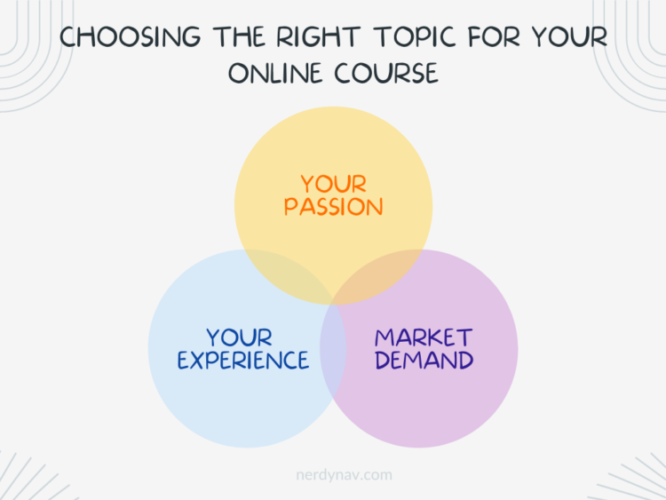
You want a topic that:
- Aligns with your interests: Your passion will engage your students. It cannot be faked.
- You have actual experience in: For adding your unique value to the course and fact-checking the content.
- Popular: Indicates revenue potential.
- Not too competitive: Higher chance of success.
Finding a Profitable Topic from Udemy
I start by going to the featured-topics page of Udemy to look for topics that are popular and selling well.
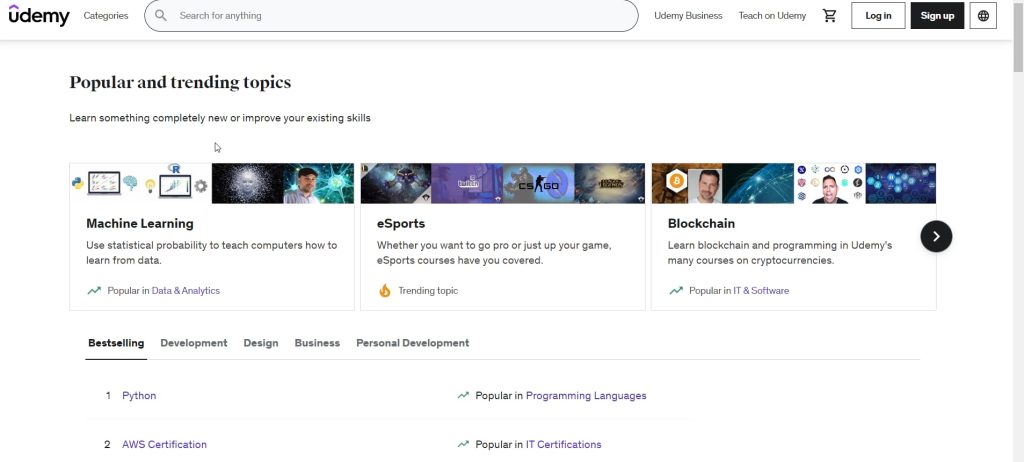
To make this blog post useful for a wider audience, I will take a non-tech topic. Let’s explore the Personal Development tab.
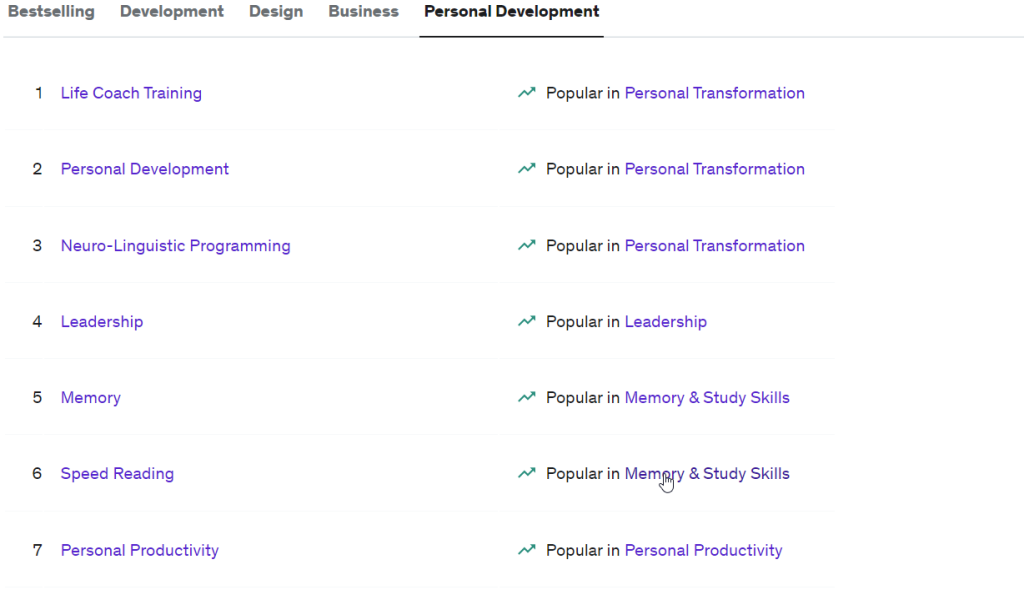
I am choosing Speed Reading in Memory & Study Skills because it is a topic with scope for actionable, scientifically proven tips, and practical examples. I want to avoid fluff.
Additionally, I feel because it is a very specific topic (Speed Reading), it might not be very competitive while still getting targeted traffic. Let’s validate my hypothesis by looking at the top categories in Memory & Study Skills.

Speed reading is a popular topic. It relates to Study Skills and Learning Strategies. There are a lot of courses on time management, personal productivity, etc so if we focus on those, we are unlikely to succeed.
By focusing on a subset of learning and memory techniques i.e speed reading, we should be able to do well. Here, looking at the top courses in Memory & Study Skills, we find that there are about 520 results.
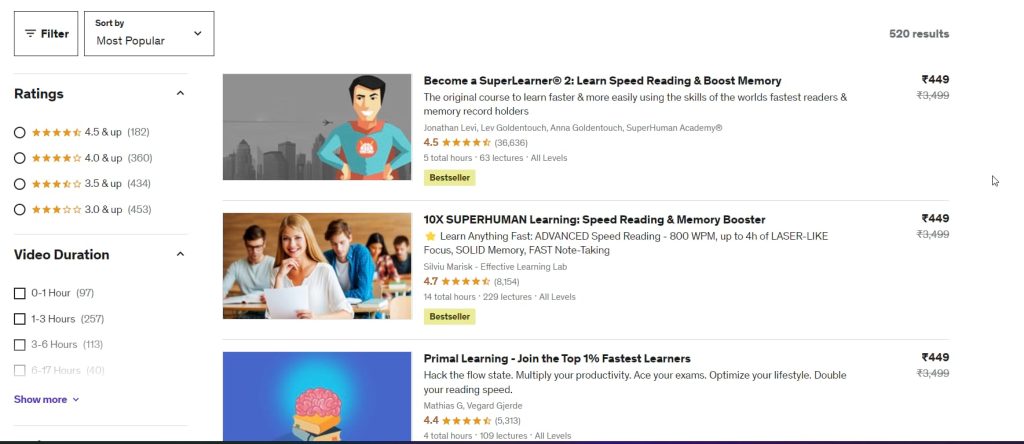
But, filtering by sub-category Speed Reading only leaves 67 results. Moreover, notice the number of reviews of the top 3 results and hours of course content.
The 1st result has 5 hours of content and approx 35k reviews. The 3rd result has 3k reviews for only 2 hours of content. As an exception, the 2nd result has a whopping 14 hours of content.
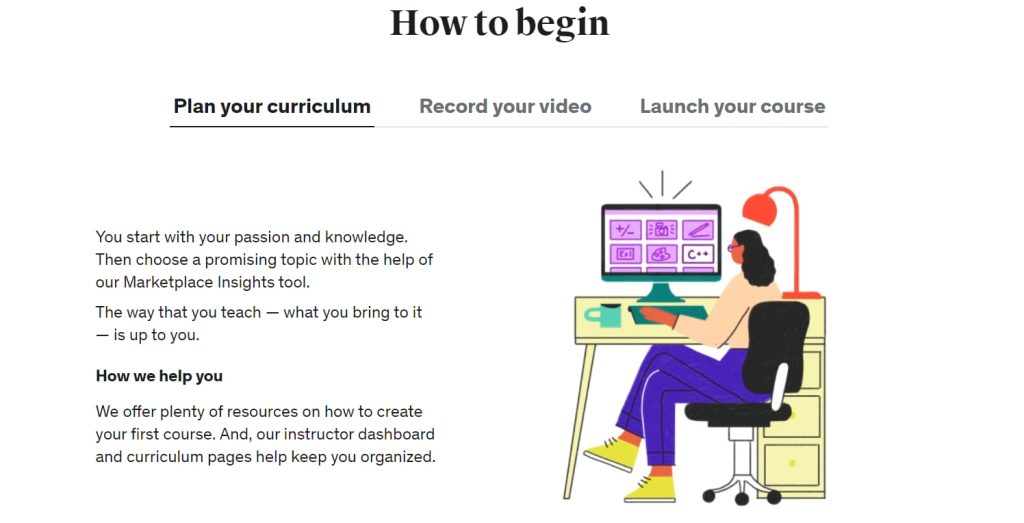
I think if we aim for nearly 6-7 hours of content that should be good enough. We don’t want to make our course too short lest it will not be very valuable. We also don’t want to make it very long as people might lose interest.
Tip: Use Udemy MarketPlace Insights to validate your shortlisted ideas against learner demand and average revenue made by instructors.
The next step is to plan our curriculum and create a course outline, content, slides, etc. Then we will record videos. Finally, we will upload our course to a teaching platform like Udemy or Thinkific to start making sales. We will also market our course.
Creating an Online Course With ChatGPT
Once we have narrowed down our course topic, we can use ChatGPT to generate sub-topic ideas, course outlines, presentation and video lecture scripts.
I will also use ChatGPT to create digital products related to our course to give to students (as free or paid bonuses).
Let’s feed our prompts to ChatGPT and create an amazing online course with AI.
Telling ChatGPT to create a course outline.
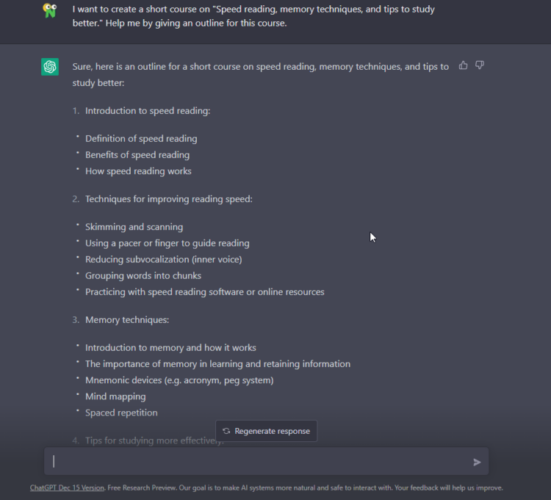
ChatGPT prompt: I want to create a short course on “Speed reading, memory techniques, and tips to study better.” Help me by giving an outline for this course.
Telling ChatGPT to create content for modules.
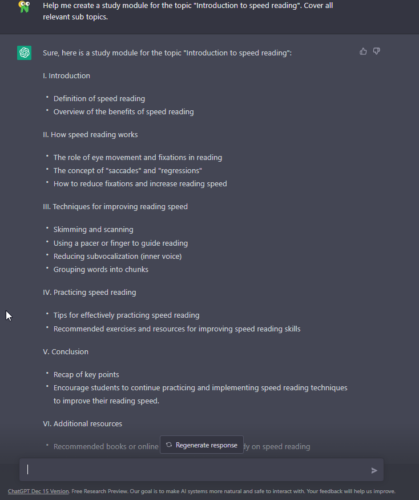
Prompt: Help me create a study module for the topic “Introduction to speed reading”. Cover all relevant sub topics.
Telling it to create content for course presentation.

Prompt: I want to create a presentation for this module. Help me write the script.
Most Udemy courses have the instructor teaching with help of slides. We can get the bullet points as well as sample script on what to say with help of ChatGPT.
Ask ChatGPT to elaborate on specific sub-topics you need.

Prompt: Give practical examples of speed reading techniques. Target students and working professionals who are studying after work to upskill.
It is a good practice to give learners practical, actionable tips on how to apply what they learn.
Create presentation using Google Slides.
You can use the content generated from ChatGPT to create presentations. MS PowerPoint and Google Slides are both good tools for this.
Create a course video using a screen recording software.
Add a voice over or your own video while you go through the slide content. You can record your computer screen while you flip through the slides. OBS screen recorder, Camtasia, etc are some screen recording tools you can use.
Create landing page and social media sales copy for your course.
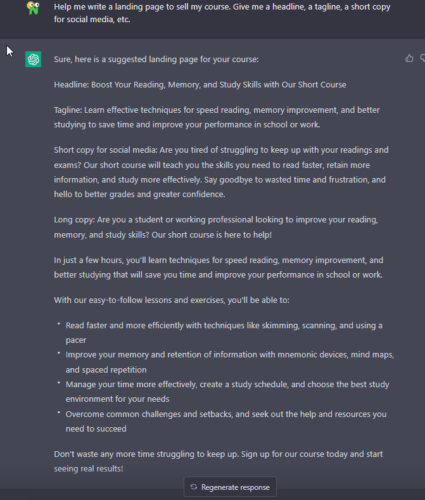
Prompt: Help me write a landing page to sell my course. Give me a headline, a tagline, a short copy for social media, etc.
Ask ChatGPT for digital product ideas related to the course.
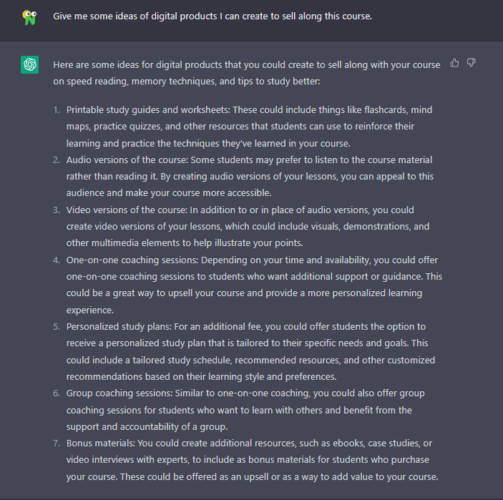
Prompt: Give me some ideas of digital products I can create to sell along this course.
You can offer these for free or as up-sell your subscribers with paid bonuses.
Use ChatGPT to create flashcards for revision.
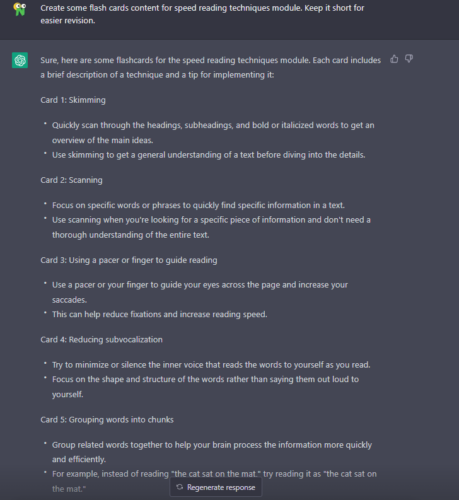
Prompt: Create some flash cards content for speed reading techniques module. Keep it short for easier revision.
Tools:
- ChatGPT for course content generation.
- Software for creating presentations like MS Powerpoint, Designs.AI, Google Slides, etc.
- Screen recording software like Bandicam, Camtasia, OBS screen recorder for making video course.
Video Tutorial: Using ChatGPT to Create an Online Course
If you prefer a video tutorial, please watch this Youtube video:
Selling Your Course Online
You can use platforms like Udemy and Thinkific to sell online courses. There are some other options but these two are the most popular ones.
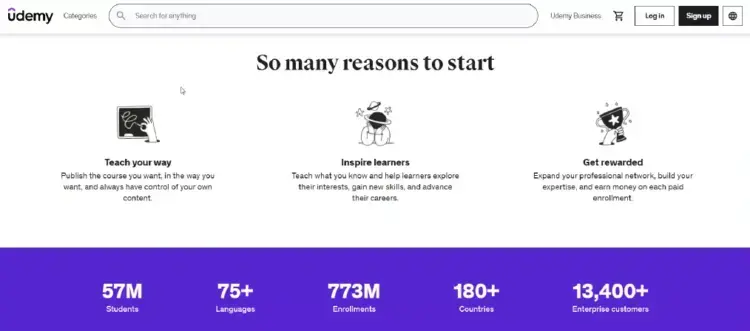
Udemy is a course marketplace. It’s like Google for courses. That means you don’t have to build an audience yourself. People will find your course (along with other instructors’ courses) when they search for the topic.
You don’t pay to create a course on Udemy but they will take a commission when you make a sale. Udemy takes up to 50% commission per sale. And, you will lose all your audience reviews if you choose to switch platforms later.

On the other hand, Thinkific is like having your own online school. You can control almost everything from creating courses, taking quizzes, building student communities, maintaining email lists, etc. This level of control is not possible in Udemy.
You have to pay Thinkific a monthly subscription but they don’t take a cut from your sales like Udemy. Thinkific also offers a free 1-month trial.
Key differences between Udemy and Thinkific
Pricing: It is free to create a course on Udemy. Udemy takes a percentage when you make a sale. On the other hand, Thinkific charges a monthly subscription fee.
Course creation: Udemy has a more limited course creation tool, while Thinkific offers more flexibility and options for customizing your course content and design.
Marketing and promotion: Thinkific offers more robust marketing and promotional tools, including the ability to create landing pages and integrations with email marketing platforms. Udemy does more of the marketing for you but takes a larger percentage of each sale as a result.
Ownership and control: With Thinkific, you have more control over the pricing and branding of your courses, as well as the student experience. With Udemy, you cede some control to the platform in exchange for their promotion of your course.
Put simply: For the short term, Udemy is good enough but for long-term or serious ventures, I recommend Thinkific. Choose Udemy if you have no audience yet. Choose Thinkific if you have an audience already and want to fully control course experience/branding.
Tip: Sell your course before you create it.
All startups evaluate demand before entering the market. Crowdfunding sites like Kickstarter are based on this exact concept.
Why pre-sell online courses?
- Validates your course idea in the market.
- Saves time and resources.
- Pre-sales provide funds for your course.
- Builds customer list.
How to pre-sell online courses?
- Do competitor research and create a plan for your course (don’t create videos & other course content, yet).
- Share the title and outline with your target audience (via Webinars, Youtube live, Instagram, etc).
- Ask your target audience about what they want in the course (Or do internet research).
- Set a price (can ask for feedback on what people are willing to pay).
- Create a sales page to collect payments.
- You will also need a business logo. Use Canva to create one from 100s of pre-existing templates.
Tip: You can launch a pilot course with a smaller syllabus at reduced prices. In software development, such a product is called Minimum Viable Product. It means giving your customers an initial version of the product that offers some value (but isn’t the complete product).
You can use Thinkific to create a sales page. Online course creators like Matt Kohn have been able to generate $30,000 in sales even before creating a single lesson. That’s the power of pre-selling.
Be up-front with your audience that the course is not ready yet. State clearly that you are looking for support to fund the course and will refund everyone if you don’t get a threshold number of pre-subscribers to create the course.
Caution: Be realistic with your promised timelines and stick to them. Be ready to drop the course idea and refund if you don’t get the expected subscribers.
How to create a successful marketing campaign for your course?
Identify your target audience: This will help you create targeted marketing campaigns and identify the best platforms to sell your course on. Do your potential students hang out on Reddit or quora? Do they ask for support in FB groups?
Create a landing page: A landing page is a standalone web page, created specifically for the purpose of a marketing or advertising campaign. It’s designed to direct the visitor to take a specific action, such as signing up for a free trial or purchasing a course. Thinkific provides highly customizable landing pages for online course creators.
Utilize social media: Use social media platforms to promote your course and engage with potential students. Share updates, testimonials, and free resources to build interest in your course.
Offer a free preview: Consider offering a free preview or sample of your course to give potential students a taste of what they can expect. This can help build trust and increase conversions.
Run a promotion or sale: Consider offering a promotion or sale on your course to drive enrollment and create a sense of urgency.
Utilize email marketing: Consider sending out newsletters, promotional emails, and automated email campaigns to keep people interested in your course.
Use paid advertising: Paid advertising, such as Google AdWords or Facebook Ads, can be a great way to get your course in front of a wider audience. Be sure to set clear goals and track your results to ensure that your advertising efforts are paying off.
Your Move
Online courses are a great way to earn passive income by sharing your skills and knowledge with others. By following the tips and best practices outlined in this post, you can create and sell a course using ChatGPT that resonates with your target audience.
Don’t wait any longer to turn your passion into a profitable business – start creating your online course today!
- 5 Best No-Code App Builders 2024 (used by actual startups) - June 15, 2024
- 5 Successful No Code Startups and Companies 2024 (with Tech Stack) - January 26, 2024
- AI Sleeper Agents: Latest Danger to AI Safety (Anthropic Research) - January 20, 2024
